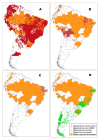Evolution of Rabies in South America and Inter-Species Dynamics (2009-2018)
- PMID: 34207822
- PMCID: PMC8293400
- DOI: 10.3390/tropicalmed6020098
Evolution of Rabies in South America and Inter-Species Dynamics (2009-2018)
Abstract
Rabies is listed as one of the World Health Organisation's (WHO) Neglected Tropical Diseases Worldwide, with a significant impact in South America. This paper explores the dynamics of rabies cases in humans, pets (dogs and cats), livestock and wildlife (bats in particular) in South America during the period 2009-2018. The data used in this study were derived from the two main databases for rabies in South America: the OIE-WAHIS from the World Organisation for Animal Health (OIE) and PANAFTOSA's Regional Information System for the Epidemiological Surveillance of Rabies (SIRVERA). Being a neglected disease with possible underreporting in some areas, the reported rabies cases may not always represent the real disease burden. The analysis focuses on the evolution of the number of cases in time and their spatial distribution, as well as on the main source of infections in humans, determined by laboratory assays of the antigenic variant or through epidemiological investigations. Additionally, Generalised Linear Mixed Models (GLMM) were used to evaluate the risk factors associated with the occurrence of human cases. Our results show that the highest impact of the disease in terms of number of cases was reported on livestock, while the overall number of cases (in animals and humans) progressively decreased along the study period. The spatial distribution of rabies in livestock showed two main clusters in the north-western (mainly Colombia) and in the south-eastern part of the affected area (Brazil), and a third smaller cluster in Peru. A cluster in dogs was observed in Bolivia. Out of the 192 human cases reported during the study period, 70% of them were transmitted by bats. The number of human cases reported during the study period were significantly associated with the number of rabies cases reported in livestock, pets and wildlife. Despite the overall decreasing case report rate, the disease still represents a major animal and public health concern in South America, and new strategies for compiling systematic information, networking and education are needed, as well as the education and training of veterinary staff.
Keywords: Desmodus rotundus; OIE-WAHIS; SIRVERA; dog-mediated rabies; infectious diseases; livestock; rabies; surveillance; vampire bat; veterinary public health; wildlife disease.
Conflict of interest statement
The authors declare that the research was conducted in the absence of any commercial or financial relationships that could be construed as a potential conflict of interest.
Figures



References
-
- International Committee on Taxonomy of Viruses (ICTV) [(accessed on 3 June 2021)]; Available online: https://talk.ictvonline.org/
-
- World Health Organization (WHO) International Health Regulations 2005. 2nd. WHO; Geneva, Switzerland: 2008. [(accessed on 27 May 2021)]. Available online: https://www.who.int/publications/i/item/9789241580410.
LinkOut - more resources
Full Text Sources
Miscellaneous

